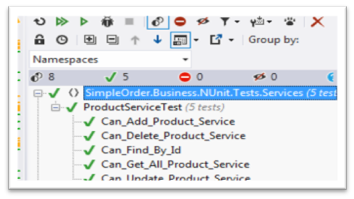How to implement NUnit Test in visual studio 2012
Owned by Bantyder Bahru (Unlicensed)
Download Source
Install NUnit Test Adapter
This test adapter is used as a bridge between Visual Studio and NUnit framework can be used from within Visual Studio IDE.
- Click Tools->Extensions and Updates…
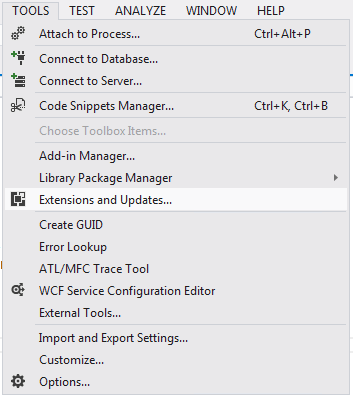
- It will open Extensions and Updates dialog box , click online and Type nunit in the search box
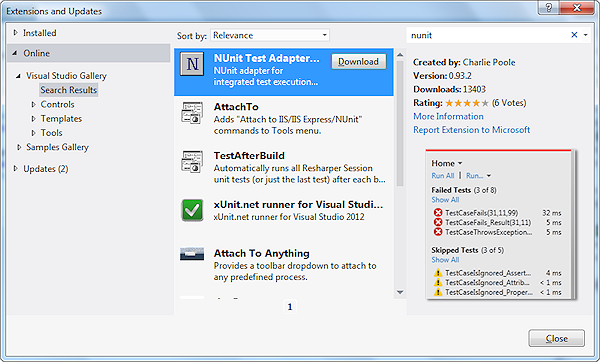
- Click download button will download and install necessary components on your machine.
- After installation you have to restart visual studio
To implement NUnit in your Test Project
- Create your unit test project
- From menu Click PROJECT->Manage NuGet Package…
- You will presented NuGet Package Manger
- Click Online and type nunit in search dialog box
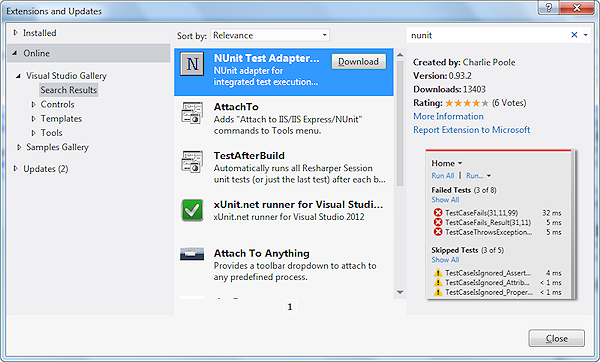
- Now click on the install button to install NUnit Package in the unit test project ,
Note: Make sure you have selected your unit test project. - Now NUnit is ready
- Reference project you want to test , in this case reference SimpleOrder.Business
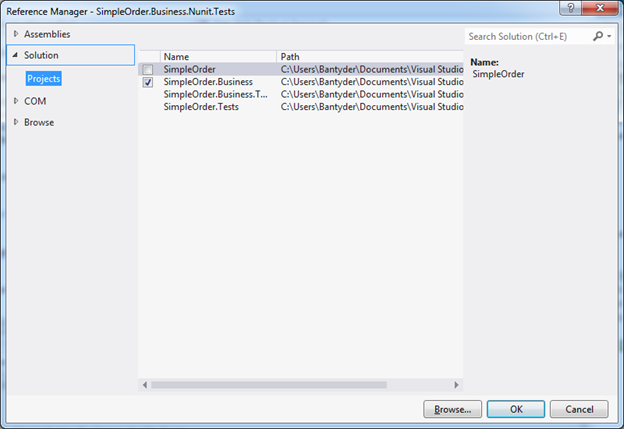
- If you need some mocking install Moq in you test project.
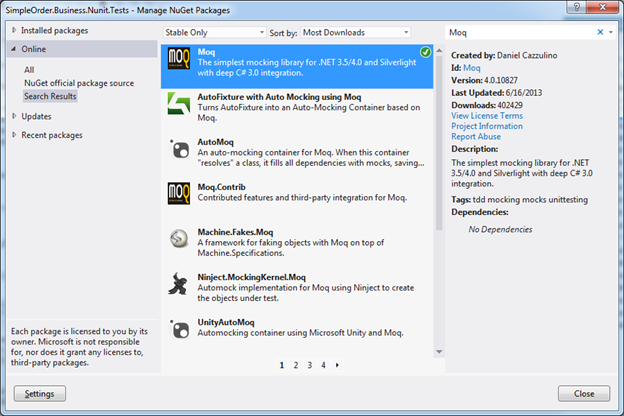
- Everything is ready to write your test.
- Right click on your test Project and add UnitTest class
- In your test class make sure to replace the following namespace from using
using Microsoft.VisualStudio.TestTools.UnitTesting;
//by
using NUnit.Framework;
12. In your test class
Add class attribute [TestFixture] instead of [TestClass]
Add test method attribute [Test] instead of [TestMethod]
13. And our test method will be as shown below
Product Service NUnit Unit Test Expand source
using System;
using System.Collections.Generic;
using System.Linq;
using NUnit.Framework;
using Moq;
using SimpleOrder.Business.Models;
using SimpleOrder.Business.Repository;
using SimpleOrder.Business.Service;
using SimpleOrder.Business.UnitWork;
namespace SimpleOrder.Business.NUnit.Tests.Services
{
[TestFixture]
public class ProductServiceTest
{
[Test]
public void Can_Add_Product_Service()
{
//Arrange
List<Product> products = new List<Product>()
{
new Product(){Description="P1",ProductId=1,ProductName="p1Name"},
new Product(){Description="P2",ProductId=2,ProductName="p2Name"},
new Product(){Description="P3",ProductId=3,ProductName="p3Name"},
new Product(){Description="P4",ProductId=4,ProductName="p4Name"},
new Product(){Description="P5",ProductId=5,ProductName="p5Name"},
new Product(){Description="P6",ProductId=6,ProductName="p6Name"},
};
Mock<IGenericRepository<Product>> mock1 = new Mock<IGenericRepository<Product>>();
//Here we are going to mock repository GetAll method
mock1.Setup(m => m.GetAll()).Returns(products);
//Here we are going to mock repository Add method
mock1.Setup(m => m.Add(It.IsAny<Product>())).Returns((Product target) =>
{
var original = products.FirstOrDefault(
q => q.ProductId == target.ProductId);
if (original != null)
{
return false;
}
products.Add(target);
return true;
});
//Now we have our repository ready for property injection
//Here we are going to mock our IUnitOfWork
Mock<IUnitOfWork> mock = new Mock<IUnitOfWork>();
//Here we are going to inject our repository to the property
//mock.SetupProperty(m => m.ProductRepository).SetReturnsDefault(mock1.Object);
mock.Setup(m => m.ProductRepository).Returns(mock1.Object);
//Now our UnitOfWork is ready to be injected to the service
//Here we inject UnitOfWork to constractor of our service
ProductService productService = new ProductService(mock.Object);
//Act
productService.AddProduct(new Product
{
ProductId = 7,
ProductName = "P7Name",
Description = "P7"
});
var result = productService.GetAllProduct();
var newProduct = result.FirstOrDefault(t => t.ProductId == 7);
//Assert
Assert.AreEqual(products.Count, result.Count);
Assert.AreEqual("P7Name", newProduct.ProductName);
Assert.AreEqual("P7", newProduct.Description);
}
[Test]
public void Can_Get_All_Product_Service()
{
//Arrange
List<Product> products = new List<Product>()
{
new Product(){Description="P1",ProductId=1,ProductName="p1Name"},
new Product(){Description="P2",ProductId=2,ProductName="p2Name"},
new Product(){Description="P3",ProductId=3,ProductName="p3Name"},
new Product(){Description="P4",ProductId=4,ProductName="p4Name"},
new Product(){Description="P5",ProductId=5,ProductName="p5Name"},
new Product(){Description="P6",ProductId=6,ProductName="p6Name"},
};
Mock<IGenericRepository<Product>> mock1 = new Mock<IGenericRepository<Product>>();
//Here we are going to mock repository GetAll method
mock1.Setup(m => m.GetAll()).Returns(products);
//Now we have our repository ready for property injection
//Here we are going to mock our IUnitOfWork
Mock<IUnitOfWork> mock = new Mock<IUnitOfWork>();
//Here we are going to inject our repository to the property
mock.Setup(m => m.ProductRepository).Returns(mock1.Object);
//Now our UnitOfWork is ready to be injected to the service
//Here we inject UnitOfWork to constractor of our service
ProductService productService = new ProductService(mock.Object);
//Act
var result = productService.GetAllProduct();
//Assert
Assert.AreEqual(products,result);
}
[Test]
public void Can_Update_Product_Service()
{
//Arrange
List<Product> products = new List<Product>()
{
new Product(){Description="P1",ProductId=1,ProductName="p1Name"},
new Product(){Description="P2",ProductId=2,ProductName="p2Name"},
new Product(){Description="P3",ProductId=3,ProductName="p3Name"},
new Product(){Description="P4",ProductId=4,ProductName="p4Name"},
new Product(){Description="P5",ProductId=5,ProductName="p5Name"},
new Product(){Description="P6",ProductId=6,ProductName="p6Name"},
};
Mock<IGenericRepository<Product>> mock1 = new Mock<IGenericRepository<Product>>();
//Here we are going to mock repository Edit method
mock1.Setup(m => m.Edit(It.IsAny<Product>())).Returns((Product target) =>
{
var original = products.FirstOrDefault(
q => q.ProductId == target.ProductId);
if (original == null)
{
return false;
}
original.ProductName = target.ProductName;
original.Description = target.Description;
return true;
});
//Now we have our repository ready for property injection
//Here we are going to mock our IUnitOfWork
Mock<IUnitOfWork> mock = new Mock<IUnitOfWork>();
//Here we are going to inject our repository to the property
mock.Setup(m => m.ProductRepository).Returns(mock1.Object);
//Now our UnitOfWork is ready to be injected to the service
//Here we inject UnitOfWork to constractor of our service
ProductService productService = new ProductService(mock.Object);
//Act
var updatedProduct = new Product() {ProductId = 1, ProductName = "p1NameModified", Description = "p1Modified"};
productService.UpdateProduct(updatedProduct);
var actualProduct = products.FirstOrDefault(t => t.ProductId == 1);
//Assert
Assert.AreEqual(actualProduct.ProductName ,updatedProduct.ProductName);
Assert.AreEqual(actualProduct.Description, updatedProduct.Description);
}
[Test]
public void Can_Delete_Product_Service()
{
//Arrange
List<Product> products = new List<Product>()
{
new Product(){Description="P1",ProductId=1,ProductName="p1Name"},
new Product(){Description="P2",ProductId=2,ProductName="p2Name"},
new Product(){Description="P3",ProductId=3,ProductName="p3Name"},
new Product(){Description="P4",ProductId=4,ProductName="p4Name"},
new Product(){Description="P5",ProductId=5,ProductName="p5Name"},
new Product(){Description="P6",ProductId=6,ProductName="p6Name"},
};
Mock<IGenericRepository<Product>> mock1 = new Mock<IGenericRepository<Product>>();
//Here we are going to mock repository FindById Method
mock1.Setup(m => m.FindById(It.IsAny<int>())).Returns((int i) => products.Single(x => x.ProductId == i));
//Here we are going to mock repository Delete method
mock1.Setup(m => m.Delete(It.IsAny<Product>())).Returns((Product target) =>
{
var original = products.FirstOrDefault(
q => q.ProductId == target.ProductId);
if (original == null)
{
return false;
}
products.Remove(target);
return true;
});
//Now we have our repository ready for property injection
//Here we are going to mock our IUnitOfWork
Mock<IUnitOfWork> mock = new Mock<IUnitOfWork>();
//Here we are going to inject our repository to the property
mock.Setup(m => m.ProductRepository).Returns(mock1.Object);
//Now our UnitOfWork is ready to be injected to the service
//Here we inject UnitOfWork to constractor of our service
ProductService productService = new ProductService(mock.Object);
//Act
productService.DeleteProduct(6);
var result = products.FirstOrDefault(t => t.ProductId == 6);
//Assert
Assert.IsNull(result);
Assert.IsTrue(products.Count ==5);
}
[Test]
public void Can_Find_By_Id()
{
//Arrange
List<Product> products = new List<Product>()
{
new Product(){Description="P1",ProductId=1,ProductName="p1Name"},
new Product(){Description="P2",ProductId=2,ProductName="p2Name"},
new Product(){Description="P3",ProductId=3,ProductName="p3Name"},
new Product(){Description="P4",ProductId=4,ProductName="p4Name"},
new Product(){Description="P5",ProductId=5,ProductName="p5Name"},
new Product(){Description="P6",ProductId=6,ProductName="p6Name"},
};
Mock<IGenericRepository<Product>> mock1 = new Mock<IGenericRepository<Product>>();
//Here we are going to mock repository FindById Method
mock1.Setup(m => m.FindById(It.IsAny<int>())).Returns((int i) => products.Single(x => x.ProductId == i));
//Now we have our repository ready for property injection
//Here we are going to mock our IUnitOfWork
Mock<IUnitOfWork> mock = new Mock<IUnitOfWork>();
//Here we are going to inject our repository to the property
mock.Setup(m => m.ProductRepository).Returns(mock1.Object);
//Now our UnitOfWork is ready to be injected to the service
//Here we inject UnitOfWork to constractor of our service
ProductService productService = new ProductService(mock.Object);
//Act
var result = productService.GetProduct(6);
var expected = products.Single(t => t.ProductId == 6);
//Assert
Assert.AreEqual(expected,result);
}
}
}
14. Now you can Right click your test project and click Run Unit Tests and the result will be displayed in the test explorer.
